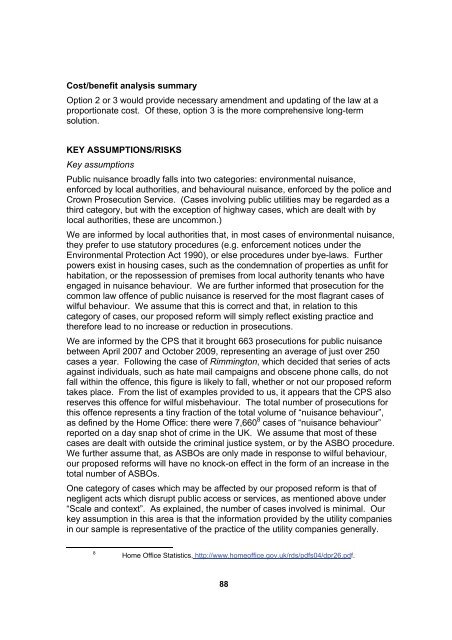public nuisance and outraging public decency - Law Commission
public nuisance and outraging public decency - Law Commission
public nuisance and outraging public decency - Law Commission
Create successful ePaper yourself
Turn your PDF publications into a flip-book with our unique Google optimized e-Paper software.
Cost/benefit analysis summary<br />
Option 2 or 3 would provide necessary amendment <strong>and</strong> updating of the law at a<br />
proportionate cost. Of these, option 3 is the more comprehensive long-term<br />
solution.<br />
KEY ASSUMPTIONS/RISKS<br />
Key assumptions<br />
Public <strong>nuisance</strong> broadly falls into two categories: environmental <strong>nuisance</strong>,<br />
enforced by local authorities, <strong>and</strong> behavioural <strong>nuisance</strong>, enforced by the police <strong>and</strong><br />
Crown Prosecution Service. (Cases involving <strong>public</strong> utilities may be regarded as a<br />
third category, but with the exception of highway cases, which are dealt with by<br />
local authorities, these are uncommon.)<br />
We are informed by local authorities that, in most cases of environmental <strong>nuisance</strong>,<br />
they prefer to use statutory procedures (e.g. enforcement notices under the<br />
Environmental Protection Act 1990), or else procedures under bye-laws. Further<br />
powers exist in housing cases, such as the condemnation of properties as unfit for<br />
habitation, or the repossession of premises from local authority tenants who have<br />
engaged in <strong>nuisance</strong> behaviour. We are further informed that prosecution for the<br />
common law offence of <strong>public</strong> <strong>nuisance</strong> is reserved for the most flagrant cases of<br />
wilful behaviour. We assume that this is correct <strong>and</strong> that, in relation to this<br />
category of cases, our proposed reform will simply reflect existing practice <strong>and</strong><br />
therefore lead to no increase or reduction in prosecutions.<br />
We are informed by the CPS that it brought 663 prosecutions for <strong>public</strong> <strong>nuisance</strong><br />
between April 2007 <strong>and</strong> October 2009, representing an average of just over 250<br />
cases a year. Following the case of Rimmington, which decided that series of acts<br />
against individuals, such as hate mail campaigns <strong>and</strong> obscene phone calls, do not<br />
fall within the offence, this figure is likely to fall, whether or not our proposed reform<br />
takes place. From the list of examples provided to us, it appears that the CPS also<br />
reserves this offence for wilful misbehaviour. The total number of prosecutions for<br />
this offence represents a tiny fraction of the total volume of “<strong>nuisance</strong> behaviour”,<br />
as defined by the Home Office: there were 7,660 8 cases of “<strong>nuisance</strong> behaviour”<br />
reported on a day snap shot of crime in the UK. We assume that most of these<br />
cases are dealt with outside the criminal justice system, or by the ASBO procedure.<br />
We further assume that, as ASBOs are only made in response to wilful behaviour,<br />
our proposed reforms will have no knock-on effect in the form of an increase in the<br />
total number of ASBOs.<br />
One category of cases which may be affected by our proposed reform is that of<br />
negligent acts which disrupt <strong>public</strong> access or services, as mentioned above under<br />
“Scale <strong>and</strong> context”. As explained, the number of cases involved is minimal. Our<br />
key assumption in this area is that the information provided by the utility companies<br />
in our sample is representative of the practice of the utility companies generally.<br />
8 Home Office Statistics, http://www.homeoffice.gov.uk/rds/pdfs04/dpr26.pdf.<br />
88

















